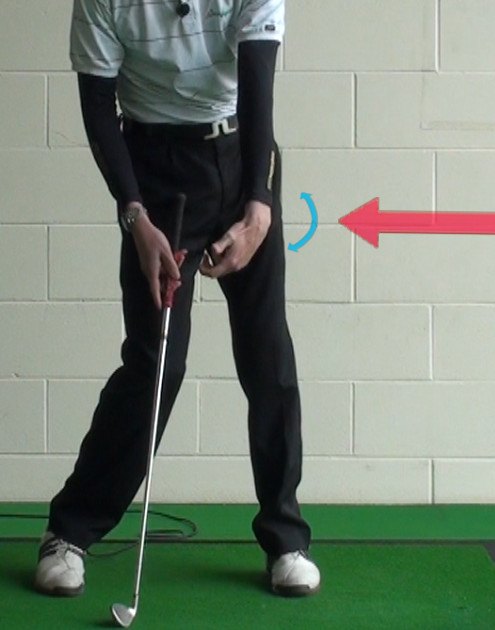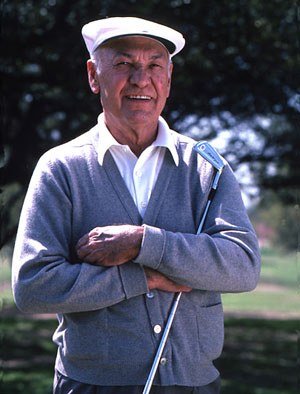
Just as Bob Dylan influenced generations of songwriters and Aretha Franklin's voice spawned legions of throaty imitators, Ben Hogan's golf swing continues to shape the methods of modern pros.
Simply put, Hogan created the template for the modern golf swing. Specific elements of Hogan's technique – the powerful downswing lag, the tucked right elbow, the bowed left wrist at impact – are still studied by golf instructors and tour professionals.
They don't analyze Hogan's moves for nostalgia's sake, either. While equipment has changed dramatically since Hogan's 1940s and '50s heyday, his swing remains as relevant as ever. It's hard to imagine a time when it won't be.
The mercurial rise of late-bloomer Jason Dufner brought renewed attention to Hogan's revolutionary approach. Dufner has studied “Bantam Ben” with the zeal of a scholar and deliberately modeled his own swing on Hogan's. It's hard to argue with the results: Dufner followed a runner-up finish at the 2011 PGA Championship with two wins in the first half of 2012, establishing himself as one of the game's steadiest performers.
Dufner may wear Hogan's influence on his logoed sleeve, but he's hardly alone. To draw another musical parallel, think about how traces of the Beatles' style – a bouncy piano break or intricate harmonies – show up in the songs of bands from vastly different genres. So, too, do little pieces of Hogan appear in the swings of pros who, on the surface, bear him no resemblance.

Whether they realize it or not, every pro owes something to Hogan. Just as Dylan wasn't the first great songwriter, nor Aretha the originator of soul singing, Hogan didn't invent the modern golf swing. Like his musical counterparts, he elevated an existing form to a new level through his singular genius.
To this day, golf's best players want to be like Ben.
Let's examine three key components of Hogan's swing that modern pros emulate – and how you can work these moves into your game.
Restricted Hip Turn
At the top of his backswing, Hogan's shoulders had rotated a full 90° to the target line, while his hips were at no more than 45°. This is the classic 2:1 ratio of shoulder-to-hip turn that creates tension between the upper and lower body.
Who else does it: Tiger Woods and most if not all modern pros.
Why it works: First of all, the concept of a restricted hip turn is somewhat misunderstood, even controversial. Some take it to mean that a golfer should strive for no hip turn at all, which becomes physiologically impossible once the shoulders reach a certain point. At any rate, the idea of limiting hip rotation against a big shoulder turn is a bedrock fundamental of today's teaching.
The tension between hips and shoulders may actually increase at the very beginning of the downswing, as the hips turn toward the target an instant before the shoulders do. The torque is finally released coming into and through impact, delivering a powerful, accelerating blow.

How it can work for you: The “flat-footed drill” is a great practice tool for building a full shoulder turn that generates tension between upper and lower body. It'll enhance your flexibility, too, and you can even do it at home without a golf ball:
- Assume your normal driver setup, with the feet shoulder-width apart (insides of feet even with outsides of shoulders).
- Swing slowly to the top, keeping both feet and heels flat on the ground. Your back and midsection will stretch noticeably on the way up.
- Don't lift your upper body on the backswing; rotating around the spine is key.
- Strive for a 90° turn with the shoulders; the left shoulder should be under your chin.
- Finish the swing.
Follow these links to learn Hogan's other key moves as practiced by current stars:
Tucked Right Elbow – Jason Dufner
Downswing Lag – Sergio Garcia

Ben Hogan Had a Lasting Impact on Modern Pros
Ben Hogan was one of the greatest players in the history of the game of golf, and his impact on the game continues to be felt to this day. Even if you are unfamiliar with much of the history of golf, you are certainly familiar with Hogan's name, as it continues to be prominent to this day - nearly 20 years after his death. Hogan is among a short list of players who impacted the game in a variety of ways that are sure to carry on for as long as golf is played. Every golfer – from the touring professional to the total beginner – stands to benefit from the many lessons that Hogan left behind.
While it is always hard to compare players of different eras in any sport, there can be no debate that Ben Hogan was one of the greatest ball strikers in golf history. In fact, some would argue that he was the single greatest ball striker in the history of the game. A statement like that will always be up for some debate, but in the end it doesn't really matter how the best of the best are ranked – Hogan will forever be remembered for his ability to consistently strike the golf ball with an accurate and powerful blow. Unlike many of the top players today, who are often over six feet tall, Hogan was a relatively small man in stature, standing under 5'9'' and weighing just 145 pounds. It seemed to make no difference, however, on the course, where he was a true giant of the game.
A quick look at Hogan's career statistics will tell you all you need to know about this legendary golfer. For starters, Hogan won nine major championships, as a professional – only Nicklaus, Woods, and Hagen have won more. Those nine majors are part of his 69 career professional wins, 64 of which came on the PGA Tour. Hogan is among a group of five golfers to have successfully completed the career Grand Slam, having taken home each of the four major championships at least once. His best major was the U.S. Open, which he claimed a total of four times, the first in 1948 and the last in 1953.
It would be easy to go on and on with statistics that point to the greatness of Hogan's career. Any way you look at it, the numbers always add up to the same thing – Hogan is truly one of the all-time greats, and a legend of the game. However, it would be a mistake to think that his legacy in the game of golf is simply tied to his abilities on the course as a competitor. In fact, many modern players know Hogan more for the swing lessons he taught than the tournaments that he won. Hogan's book, Five Lessons: The Modern Fundamentals of Golf, is one of the most-popular and most-successful golf instruction books in history. It is largely this book, along with Hogan's incredibly ball striking talent, that has led to him becoming an unforgettable figure in the history of golf.
In the content below, we will take a closer look at some of the many ways in which Ben Hogan made a lasting mark on the game of golf, and how his influence continues to affect professional golfers to this day. Also, we will highlight some tips that can help you improve your own performance on the course.

Dedication to Practice
One of the strongest impacts that Hogan had on the professional game was simply his dedication to practice – especially when it came to his swing. Hogan was famous for his long and focused practice sessions, during which he would strike ball after ball with incredible precision. Many professional golfers today spend hours at a time on the range working on their technique, and they can likely thank Hogan for setting that standard many years ago. It could be argued that Hogan raised the bar for all pro golfers, as they had to work extremely hard if they wanted to keep up with him on the course.
In today's game, it is simply assumed that you will spend hours and hours on the range and on the practice green if you hope to be one of the best players in the world. In fact, it would simply be impossible to rise in the ranks of professional golfers without putting in that time upfront. From the very best players down to the fringe professionals who are barely scraping out a living, all have to work as hard as possible in order to get the most from their games. The golf you see played on the weekends of PGA Tour events might look fun and glamourous, but you can be sure that countless hours of hard work has been required to reach that point. While golfers certainly practiced their games before Hogan came along, his effort and performance made it a necessary for others to follow suit.
As many golfers have heard over the years, Hogan was fond of saying that a golfer's swing had to be found 'in the dirt'. This, of course, meant that the swing could only be discovered through hard work and consistently practice. By hitting shot after shot, day after day, for a long period of time, one could discover his or her own swing successfully. Without these practice sessions, it would be impossible to ever gain control and mastery over one's swing. If you are trying to improve the level of your own game, you would be wise to heed the advice that was given by Mr. Hogan and practice your swing as much as possible in order to discover the technique that is going to work for you.
A large number of golfers today seem to believe that they simply need to follow a 'formula' for creating a good golf swing. Once they are able to get into all of the correct positions throughout the swing, they expect to hit good shots and shoot good scores. Unfortunately, that isn't usually how it works. This is why Hogan's line of thinking was so important. He understood that there is more to golf than just technical details, as the player has to be able to execute the swing in the same dynamic fashion time after time. Therefore, quality golf can be seen as a delicate combination of mechanics and rehearsal. Only when these two components come together will any player – from a pro down to a beginner – be able to play up to their capability.

The Importance of the Grip
One of the key fundamentals that was highlighted in Hogan's legendary book was the grip. Although many amateur players continue to underestimate the importance of the grip in their own game, every single professional golfer in the world understands just how important it is to form a quality grip before making a swing. With the grip being the only actual contact between your body and the club during the swing, it is crucial that this element is handled properly.
As it relates to your own game, you should pay particular attention to the way the club is placed in the left hand prior to taking your stance (for a right handed golfer). This is a point that countless amateur golfers get wrong, and it greatly damages their ability to create speed in the swing. Hogan highlights that fact that the club needs to be placed under the pad on the inside heel of the palm (which causes the club to run along the base of the fingers). When you are able to position the club in this manner, you will find that you have incredible freedom of movement in your hands and wrists when you start to make your swing.
Unfortunately, the average golfer tends to place the club in a position that has it running up the palm and into the wrist. This is a big mistake. When placed this way in your hand, you will have a hard time hinging your wrist as you go back – meaning you won't be able to create very much speed coming forward. If you think this is a mistake that has been inhibiting your game up until this point, do your best to make the change as quickly as possible. It may take some time to get used to placing your grip in a new position, but the effort will be worth it in the end.
Another point that is made by Hogan regarding the grip is the simple fact that the grip needs to be practiced over and over if it is to become natural and comfortable. In his book, Hogan promotes practicing your grip for a few minutes a day whenever you have the opportunity. Even if you aren't at the golf course or driving range, simply pick up a club from time to time and work on placing it in your hands in the correct manner. Doing this over and over again on a daily basis is sure to allow you to get comfortable with how your hands should fit around the club.
With regard to the right hand, Hogan points out that you should be focused mostly on placing the grip in your fingers when the right hand is wrapped around the club. This, of course, makes sense, as you will want the right hand to have the ability to fire the club through the ball at impact. In many ways, you can think about using your left hand to control the club while the right hand does the work of applying the speed at the bottom. According to Hogan, it is the two middle fingers on your right hand that should apply pressure to the club during the swing. When using the right hand correctly, and in concert with a proper left hand position, the grip can successfully do its job of connecting you to the golf club.
If you pay careful attention to the professional golfers that you see on TV (or in person), you will find that they take great care to form a perfect grip on the club each and every time. Of course they are quite comfortable with their grips after playing and practicing day after day, but the pros still pay attention to this basic fundamental. Many include some form of focus on the grip within their pre-shot routine, proof of just how important this part of golf technique is to your overall success or failure on the course. Professional golfers in the modern age have learned from Hogan with regard to the importance of the grip, and you would be wise to do the same.

The Value of Perseverance
Certainly it would be an overstatement to say that Ben Hogan was the first golfer to show perseverance in his career. Many of the early professional golfers had to overcome immense challenges and obstacles on the way toward building their careers, and many have had to do so since. However, with that said, few have had to overcome the same kind of challenge that was presented to Ben Hogan – and even fewer have rebounded in such an impressive way.
In February of 1949, Hogan was already a highly accomplished professional golfer when he and his wife Valerie were involved in a near-fatal car accident in Texas. The Hogan's were truly fortunate to have escaped with their lives, but the physical toll that was taken on Ben was significant to say the least. A partial list of the injuries that Mr. Hogan suffered in the accident includes a double-fracture of the pelvis, a left ankle fracture, a fractured collar bone, and more. In the end, Hogan would spend a total of 59 days in the hospital, with doctors unsure if he would ever even be able to walk again.
Of course, he did walk again. In fact, he did much more than that. While his career was certainly affected by the accident, he went on to win an incredible six major championships after he had been so badly hurt. One of the biggest effects of the car accident on Hogan's career may have been his inability to continue competing for the PGA Championship. At the time, the PGA was a match play event, which often required players to complete more than one match per day. The physical toll of this format was simply too much for Hogan to demand of his body, so he declined to play in the years following his accident. Considering the fact that he had won two of the three previous PGA Championships prior to his accident, it is a safe bet that Hogan would have added to his major championship total were it not for the injuries he suffered.
It is impossible to know just what effect Hogan returning from such a serious accident had on future generations of golfers, but it seems likely that the effect was significant. Seeing one of the very best players in the world become so badly hurt, only to return and play at the top of the game once again, is certainly inspirational for others making their living in the same way. Also, Hogan's accident likely placed golf in perspective for a number of other pros, as they would have certainly seen just how temporary and fragile life and success can be.
The impressive manner in which Hogan was able to return to professional golf from such a serious accident is not only one of the best stories in golf history – it is one of the best stories in sports history as a whole. His is a story which will always be the subject of some debate among those who study golf history, as it is interesting to contemplate just how many tournaments Hogan could have won without the interference of the accident. Would he actually own the major championships record instead of Jack Nicklaus? Or, on the other hand, did the accident help him focus and maintain a drive for the game once he had recovered physically? There is no right or wrong answer on this point, but it certainly makes for an interesting discussion.

Business Off of the Course
It is no secret that today's top golfers make incredible amounts of money. Players like Jordan Spieth and Rory McIlroy are among the richest athletes in the world, with their incomes stemming largely from endorsements and other endeavors away from the course. Sure, they take home huge checks when they win big tournaments, but it is their business activities away from the golf course that tend to have the biggest financial implications.
With that in mind, it is probably appropriate that today's golfers give a nod to Ben Hogan for his influence on the business of the game. Many modern golfers credit Tiger Woods for providing a significant boost to their incomes – and that certainly is true – but there are older players such as Hogan and Nicklaus who deserve plenty of credit as well. Golf needs to be popular in order for the professional players to make significant incomes, and it tends to be the superstar players that dictate just how popular the game becomes in each generation.
Hogan's biggest influence on the business side of the game came through the creation of the Ben Hogan Golf Company. This business venture was a golf club company that was created in 1953 in Fort Worth, Texas. Hogan's goal was to build and market clubs toward accomplished, experienced players, rather than beginners. This was a marketing strategy that stands in contrast to what many golf club companies do with their business model, as most choose to appeal to the widest possible audience – which is players of a lower skill level. However, Hogan has a specific vision in mind for his company, and he took it in that direction.
Looking back, it is rather incredible to think about a golfer starting his own club company. While players today have a variety of business ventures to consider as they gain in fame, most of them choose to design a course or two, maybe start a clothing line, or open a winery. For the modern golfer, the closest they get to the golf club business is accepting sponsorship dollars from whichever company's clubs they choose to put in the bag. Some players will have a bit of input on club design from time to time, but mostly, they are on the sidelines when it comes to the club business.
Hogan only owned his club business for a few years, as it was sold to AMF in 1960 (although Hogan stayed on as president). However, the company continued on for several decades, going through a number of ownership groups. Eventually, the Hogan line ended up in the hands of Callaway Golf, which discontinued it back in 2008. Although the idea of players owning and operating club companies didn't become a pattern, this bold entrepreneurship idea from a professional golfer has certainly helped to set the stage for many of the successfully business activities seen today. The successful modern golfer enjoys a millionaire's lifestyle, and that can be at least to some degree attributed to the efforts of Ben Hogan.
It would be hard to overstate the impact of Ben Hogan on the golf landscape. Even if today's pros aren't all aware of the profound impact that Mr. Hogan had on the game, they would be able to find his influence all around if they were to look for it. Hogan was one of the very best players in the history of golf, and he will continue to be held in such regard for many years into the future. In addition to his legendary ball striking ability and numerous records, Hogan's comeback from such serious physical injury is something that should never be forgotten in golf circles. Golfers of all ability levels, from beginners up to top pros, should certainly speak the name Ben Hogan in a respectful and appreciative manner.






